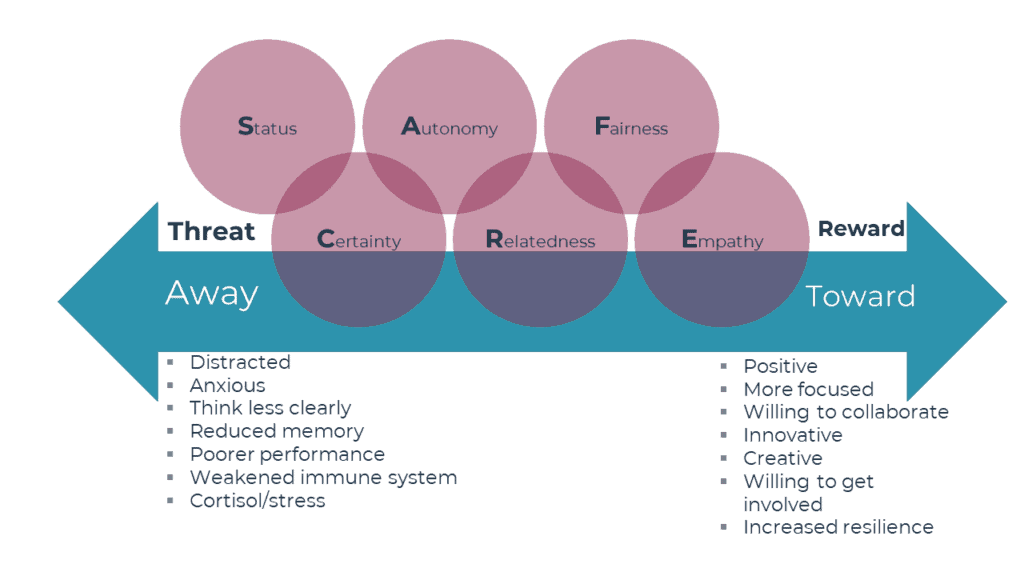What is neuroscience?
It’s not as scary as it sounds. The ‘neuro’ part means it’s about the brain and nervous system and ‘science’ is about taking a scientific approach to exploring it. What I’m talking about is applied neuroscience – what scientific study tells us about how our brains work rather than some of the older psychometrics.
The SCARF model is attributed to David Rock[1]Rock, D. 2008. SCARF: a brain-based model for collaborating with and influencing others. Accessed via David Rock’s website and I’ve also used the wonderful Hilary Scarlett’s article [2]Scarlett, H. 2013. Neuroscience: helping employees through change. Accessed on Scarlett and Grey website. on how it applies to change.
Together, neuroscience and the SCARF model help us understand how we can lead people better. For example, it can help us think about why people respond a certain way to feedback or to change.
The SCARF model

Status can be about where an employee sits within an hierarchy but it’s also the extent to which they feel respected and valued. Being asked for their opinions or to help on a significant project can boost sense of status. Knowing that they are better at a skill than others, improving at a skill or being offered a development opportunity all improve sense of status and push employees into the toward state.
We like to know what’s going to happen. Imagine how you feel when you watch a really good triller film, you’re on the edge of the sofa, wondering if the protagonist or hero will win – what’s the feeling you have?
The brain craves certainty. When it doesn’t have it, it gets distracted as it tries to work out what pieces of information mean and whether they all make sense. Employees speculate and, because there are five times more neural networks in the brain to detect threat, they become anxious and enter the threat response. To focus, their brains need open, frequent and consistent communication. This means organisations and leaders need to be as transparent with people as possible.
This is about the need to have control over our lives, or at least the perception of control. As a rule, employees aren’t keen on being micromanaged and even advice supplied with good intentions can send them into the threat response. Neuroscience demonstrates that involving people puts them into the toward state – willing to collaborate and to help make change happen.
Because human beings need others to ensure our survival, through our early
years our brains are wired to be social. We need to connect with other people. Every time we meet a new person, unconsciously our brains are thinking “friend or foe?” and because we have more neurons to detect threat, our tendency is to think “foe”. This is why unconscious bias is such a problem in organisations as anyone different to us is more likely to end up in that foe box!
When employees feel they belong to a group they enter a toward state. Time with leaders, team meetings, informal social gatherings and team based activities are not just nice to do, they lead employees to feel that they belong to “the ‘in’ group” and put their brains into a more constructive mindset. Providing employees with time to meet face-to-face isn’t a luxury – it helps them to build a sense of belonging and trust, and calms the mind.
This becomes all the more important during times of change. If things are
going to be different then an employee’s brain needs to know that the process will be fair. Fairness is rooted very deeply within us – every child is very quick to point out if something is not fair.
You might think I can’t spell scarf properly but in fact, I have added the E of empathy because a. more studies are showing how important this is (eg Naomi Eisenberger) and b. to highlight how emergent neuroscience is and to point out that there are likely to be many more dimensions than the ones shown we are yet to discover, through scientific process.
Full credit to Hilary Scarlett (see footnote) for these descriptions.
The effect of change on the brain

Downloads
SCARF model slides
References and notes[+]
| 1 | Rock, D. 2008. SCARF: a brain-based model for collaborating with and influencing others. Accessed via David Rock’s website |
|---|---|
| 2 | Scarlett, H. 2013. Neuroscience: helping employees through change. Accessed on Scarlett and Grey website. |

